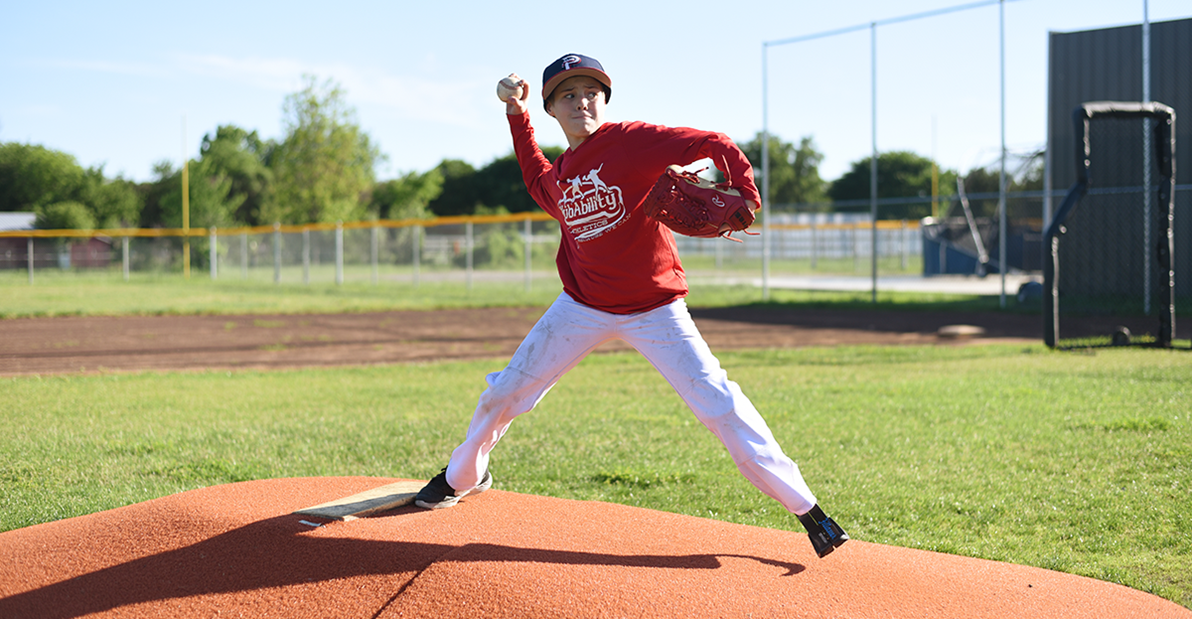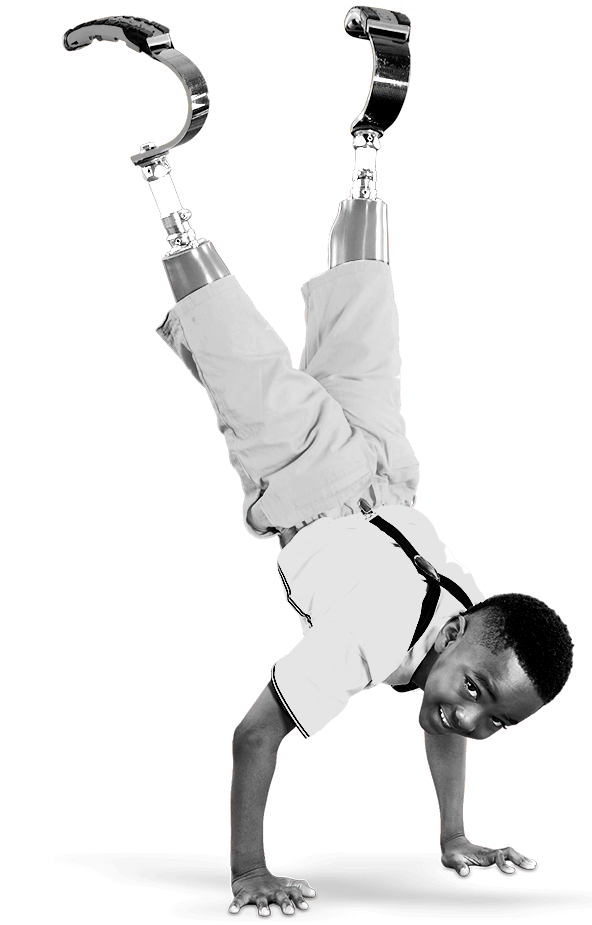
Jul 29, 2021 / Prosthetics & Orthotics
Game Changer: Laser-focused on the Future
Article previously published in Rite Up, 2021 – Issue 2.
“Baseball is just a great sport,” Austin, of Arlington, says. “It can teach you a lot of things. You can be competitive — you can be anything.”
Austin recently received a sport prosthesis, also called a blade, from Scottish Rite for Children, and he’s putting it to good use from the pitcher’s mound on his select baseball team. “When I pitch, everything just zones out, and I’m just staring at the catcher’s glove,” Austin says. “It just all goes away, everything but that glove.”
Two years ago, while riding with a family member, Austin jumped off a riding lawn mower to retrieve something, and when he returned to jump back on, his foot was caught underneath the mower deck. The injury resulted in a below-the-knee amputation, and following his initial recovery, Austin and his family found Scottish Rite to meet his prosthetic needs.
Austin’s mom, Kayla, said he experienced some ups and downs adjusting to his amputation. “He’s a very outgoing and determined kid, and that’s really been his saving grace — his personality and his whole mindset in general,” Kayla says. “He’s been able to pull through even the hard times.”
The Prosthetics team at Scottish Rite works closely with Austin, listening to his input and helping him embrace his competitive spirit and intense love of sports.
After starting baseball at an early age, Austin’s return to the diamond was inevitable. “He loves all sports,” Kayla says. “At one point or another, he’s wanted to play any sport that there is to play.”
A blade prosthesis helps increase athletic capability while running, jumping and playing, and amputees expend less energy wearing a blade during high-impact activities. “My blade leg has a lot more spring, and I can run so much faster,” Austin says. ”It gives me the ability that makes me want to go out and do stuff.”
Scottish Rite prosthetist Dwight Putnam loves to see Austin excelling at baseball. “We’ve been doing this a long time, and our outcomes are outstanding,” Putnam says. “We identify what was driving our patients before, and sort of use that as the carrot on the stick to get them emotionally and physically inspired to go through their recovery and get back to where they were.”
Austin’s confidence with his blade keeps him excited about getting back in the game, and in the fall, he has plans to play on his school’s football team. “I just really appreciate Scottish Rite getting Austin’s input as far as asking him what he wants to do, how does this make him feel and where he sees himself,” Kayla says. “They’re really just talking to Austin about it and bringing him in on the conversation.”
And Austin knows his team at Scottish Rite will be there whenever he needs support. “People there are amazing,” he says. “If I ask them something, they’ll take my advice and try to do it as much as they can.”
Being Safe With Lawn Mowers
Although commonly used, lawn mowers can be dangerous. Children tend to be attracted to mowers in use. Be sure to educate your child, when they reach the right age, about how to operate machinery safely. An adult should supervise until the equipment can be managed alone.
“Baseball is just a great sport,” Austin, of Arlington, says. “It can teach you a lot of things. You can be competitive — you can be anything.”
Austin recently received a sport prosthesis, also called a blade, from Scottish Rite for Children, and he’s putting it to good use from the pitcher’s mound on his select baseball team. “When I pitch, everything just zones out, and I’m just staring at the catcher’s glove,” Austin says. “It just all goes away, everything but that glove.”
Two years ago, while riding with a family member, Austin jumped off a riding lawn mower to retrieve something, and when he returned to jump back on, his foot was caught underneath the mower deck. The injury resulted in a below-the-knee amputation, and following his initial recovery, Austin and his family found Scottish Rite to meet his prosthetic needs.
Austin’s mom, Kayla, said he experienced some ups and downs adjusting to his amputation. “He’s a very outgoing and determined kid, and that’s really been his saving grace — his personality and his whole mindset in general,” Kayla says. “He’s been able to pull through even the hard times.”
The Prosthetics team at Scottish Rite works closely with Austin, listening to his input and helping him embrace his competitive spirit and intense love of sports.
After starting baseball at an early age, Austin’s return to the diamond was inevitable. “He loves all sports,” Kayla says. “At one point or another, he’s wanted to play any sport that there is to play.”
A blade prosthesis helps increase athletic capability while running, jumping and playing, and amputees expend less energy wearing a blade during high-impact activities. “My blade leg has a lot more spring, and I can run so much faster,” Austin says. ”It gives me the ability that makes me want to go out and do stuff.”
Scottish Rite prosthetist Dwight Putnam loves to see Austin excelling at baseball. “We’ve been doing this a long time, and our outcomes are outstanding,” Putnam says. “We identify what was driving our patients before, and sort of use that as the carrot on the stick to get them emotionally and physically inspired to go through their recovery and get back to where they were.”
Austin’s confidence with his blade keeps him excited about getting back in the game, and in the fall, he has plans to play on his school’s football team. “I just really appreciate Scottish Rite getting Austin’s input as far as asking him what he wants to do, how does this make him feel and where he sees himself,” Kayla says. “They’re really just talking to Austin about it and bringing him in on the conversation.”
And Austin knows his team at Scottish Rite will be there whenever he needs support. “People there are amazing,” he says. “If I ask them something, they’ll take my advice and try to do it as much as they can.”
Being Safe With Lawn Mowers
Although commonly used, lawn mowers can be dangerous. Children tend to be attracted to mowers in use. Be sure to educate your child, when they reach the right age, about how to operate machinery safely. An adult should supervise until the equipment can be managed alone.
- Keep children at a safe distance away from the mower.
- Before operating, a child should be at least age 12 for a push mower and age 16 for a riding mower.
- Never allow passengers to ride along.
- Clear the ground of objects that could be picked up and thrown by the mower.
- Do not pull the mower backward or drive in reverse.
- Wear eye and ear protection, closed-toe shoes and close-fitting clothes.
- Stop the engine and cool motor before refueling.
Credits: kidshealth.org; aappublications.org



